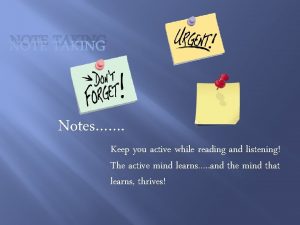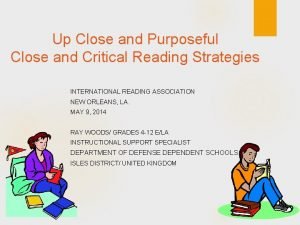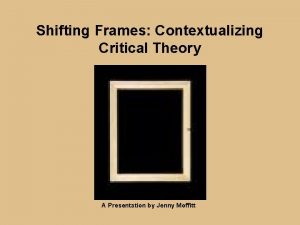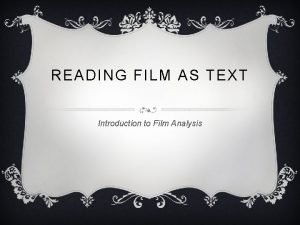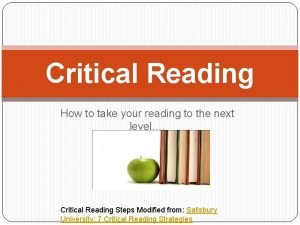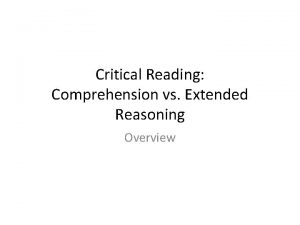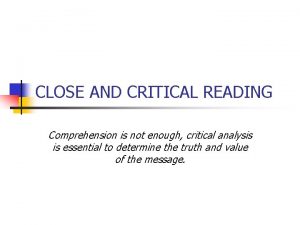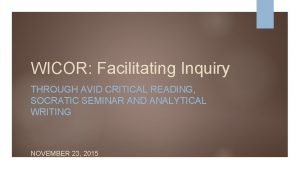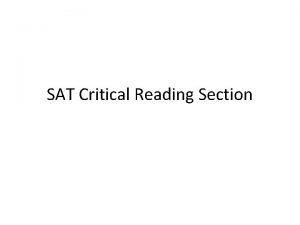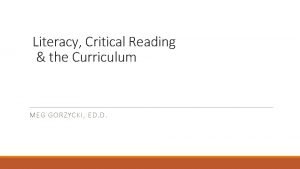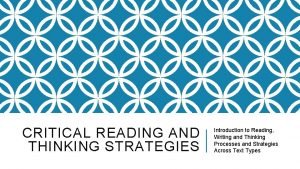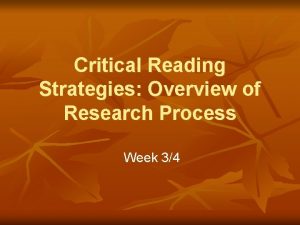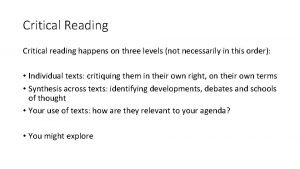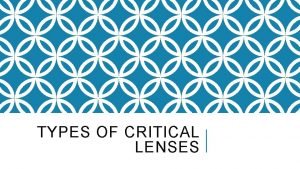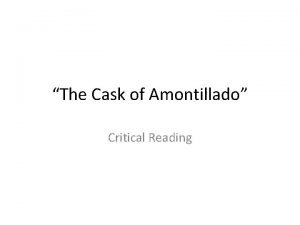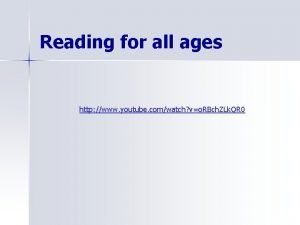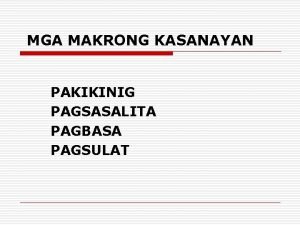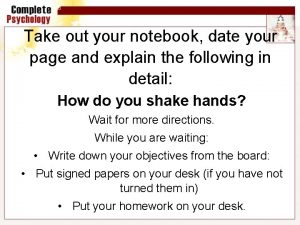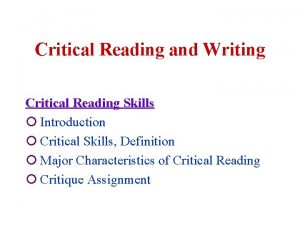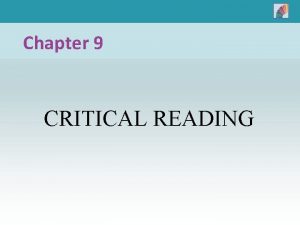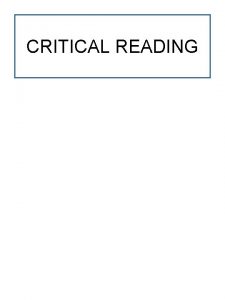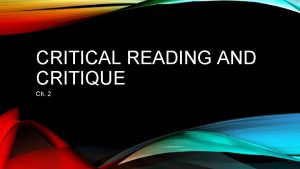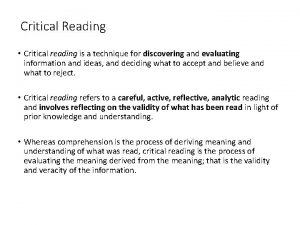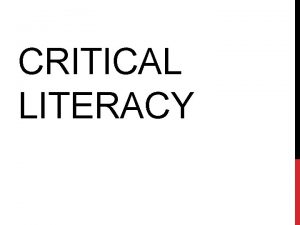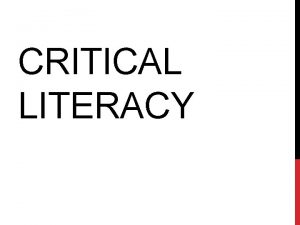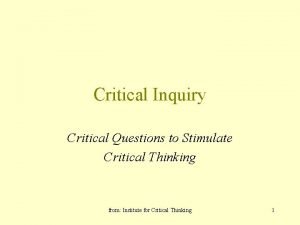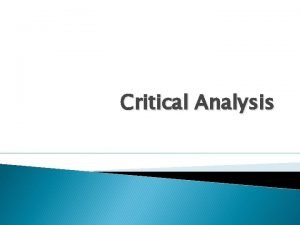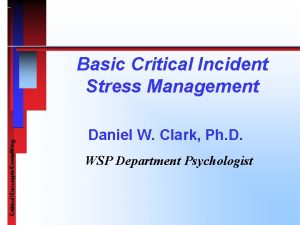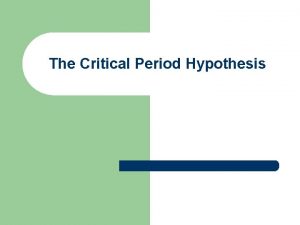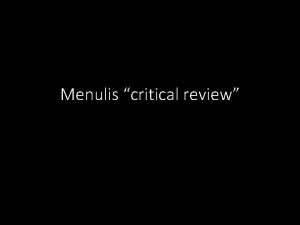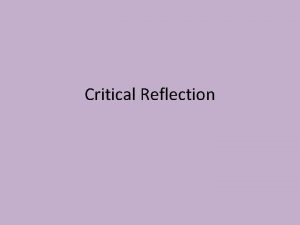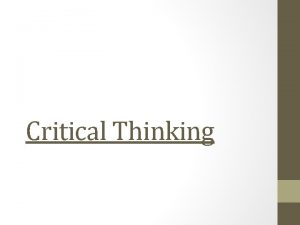Critical Reading How to take your reading to


























- Slides: 26

Critical Reading How to take your reading to the next level…. Critical Reading Steps Modified from: Salisbury University: 7 Critical Reading Strategies

What does Critical Reading mean? �On a sheet of notebook paper, take one minute to try to write down a definition for Critical Reading. �Now, turn to a partner and pair-share your definitions. �What do you think? Share as a class what you think Critical Reading means.

CRITICAL READING: Definition: Critical Reading is the opposite of careless reading. Critical Reading means to read carefully, thoughtfully, and with a purpose in order to better understand evaluate a text.

Are you a Critical Reader? �How do you usually read a text? Do you take notes? Skim? Read quickly? Turn to the person next to you and share your current reading process.

Where does Critical Reading fit in our C. A. R. E. Model?


helps us to better understand or comprehend, the text. It also prepares us for the next steps of the C. A. R. E. Learning Model.

4 Steps to Becoming a Critical Reader 1) Preview: Skim before you read 2) Contextualize: Where does it fit? 3) Ask Questions to Understand Remember 4) Identify the Main Ideas and Restate them in your Own Words

1) PREVIEW: Learning about a text before you read it What can you learn about the text before you ever read it? Take a look at titles, headings, bolded words, and pictures.

TRY IT In pairs, practice previewing today’s reading. What did you find?

Read through the passage for the 1 st time �Remember, when reading critically, you’ll usually want to read through a passage more than once. Read the first time through just to get a sense of the overall content and shape of the passage. Do not take notes. �Today we will read completely through this passage fully two times.

2) CONTEXTUALIZE: Placing a text in its historical, cultural, and biographical context When you read a text, you read it through the lens of your own experience. Your understanding of the words on the page and their significance is informed by what you have come to know and value from living in a particular time and place. But the texts you read were all written in the past, sometimes in a radically different time and place.

2) CONTEXTUALIZE: Placing a text in its historical, cultural, and biographical context Ask yourself: 1) When do the events in the reading take place? 2) Where do the events in the reading take place? 3) How might the people I’m reading about have similar or different experiences than my own?

TRY IT In pairs, practice Contextualizing today’s reading. 1) When do the events in the reading take place? 2) Where do the events in the reading take place? 3) How might the people I’m reading about have similar or different experiences than my own?

3) QUESTIONING: Asking questions to understand remember � As students, you are used to teachers asking you questions about your reading. These questions are designed to help you understand a reading and respond to it more fully. � When you need to understand use new information though it is most beneficial if you write the questions, as you read the text.

3) QUESTIONING: Asking questions to understand remember � With this strategy, you can write questions any time, but in difficult academic readings, you will understand the material better and remember it longer if you write a question for every paragraph or brief section. Each question should focus on a main idea, not on illustrations or details, and each should be expressed in your own words, not just copied from parts of the paragraph.

TRY IT Read through the passage a 2 nd time. In pairs, practice Questioning today’s reading. What questions do you have about the reading? After each section, write a question.

4) IDENTIFYING MAIN IDEAS: Identifying the main ideas and then restating them in your own words � Outlining and summarizing are especially helpful strategies for understanding the content and structure of a reading selection. � Outlining reveals the basic structure of the text � Summarizing restates a selection's main argument in brief, often in paragraph format � The key to both outlining and summarizing is being able to distinguish between the main ideas and the supporting ideas and examples. The main ideas form the backbone, the strand that holds the various parts and pieces of the text together. Outlining the main ideas helps you to discover this structure.

TRY IT In pairs, practice Identifying Main Ideas from today’s reading by outlining it. Look at the text a 3 rd time. Go back through the reading, and write a one sentence summary of the main idea of each section. (Note: Do NOT include your opinion in this step)

So…what’s the reading about? �After you’ve worked with your partner to write an outline of the article’s main ideas, take your notes with you and SWITCH PARTNERS.

So…what’s the reading about? �Now…the test. Pretend that you are in an elevator with your new partner. You’ve just read a really interesting article (the one we just read for class) and you want to tell them about it. The trick? You’ve only got 30 seconds before the elevator ride is over….

So…what’s the reading about? �In 30 seconds, tell your partner what the reading is about. �Time is limited. Tell only the most important parts. �Use your own words �You may use your notes/outline to help you. �Switch roles and let your partner try.

What do you think? �Do you feel like you understand the reading better after this process? �Pair-share

Why is Critical Reading Important? �In your notebook, list as many reasons as you can think of concerning why critical reading is important. �Pair-share

passage, you’re ready to move on to the next steps of the C. A. R. E. Learning Model. Critically Reading a passage will give you the base to be able to Critically Think about and respond to it. The steps of Analyzing, Responding, and Responding with Evidence in the C. A. R. E. model will ask you to employ these critical thinking skills.

Wrap-UP �What is one thing from today’s passage or critical reading lesson that you will take away from today? Write it down in your notebook. �Pair-share.
 Critical semi critical and non critical instruments
Critical semi critical and non critical instruments Semi critical
Semi critical Critical reading words/phrases
Critical reading words/phrases Take a bus or take a train
Take a bus or take a train Slidetodoc.com
Slidetodoc.com Pre reading while reading and post reading activities
Pre reading while reading and post reading activities Give us your hungry your tired your poor
Give us your hungry your tired your poor Should you take notes while reading
Should you take notes while reading Close and critical reading
Close and critical reading Contextualizing in critical reading
Contextualizing in critical reading Act score range
Act score range Wide reading critical film viewing
Wide reading critical film viewing What does critical reading mean
What does critical reading mean Extended reasoning
Extended reasoning Close and critical reading
Close and critical reading Wicor meaning
Wicor meaning Critical reading examples sentence
Critical reading examples sentence Critical reading definition
Critical reading definition Critical reading meaning
Critical reading meaning Process of discovery in critical reading
Process of discovery in critical reading Three domains of critical reading
Three domains of critical reading Literary critical lenses
Literary critical lenses Poe is a master at creating an eerie
Poe is a master at creating an eerie Critical reading meaning
Critical reading meaning Halimbawa ng kasanayan o skills
Halimbawa ng kasanayan o skills Take out your notebook
Take out your notebook Take out your homework
Take out your homework







